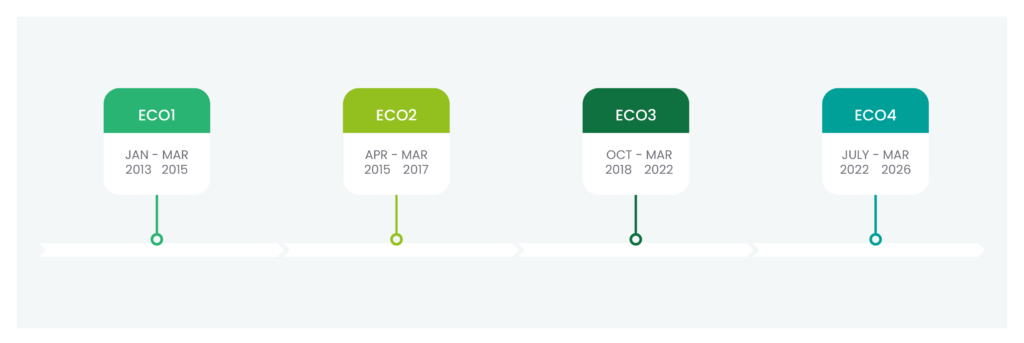The History of ECO4
Contents
What is the ECO Scheme?
The ECO4 Scheme is the 4th iteration of the Energy Company Obligation (ECO) scheme, a programme that has been in place since 2013 to reduce carbon emissions and help improve energy efficiency throughout the UK. ECO has seen different phases throughout its lifetime, and each one has had different goals and targets as part the broader plan to make the UK a greener country, and importantly tackle fuel poverty.
Who is funding the ECO Scheme?
Despite being a government scheme, the funding for ECO comes from energy companies. This means that the measures put in place to improve the energy efficiency of qualifying households throughout the country isn’t being paid for by taxpayers. The types of measures that have made available through the ECO scheme have changed over time, as has the qualifying criteria for households across the country.
The energy companies have certain targets that they have to meet for the number of homes they have to help improve under the ECO scheme, and if they don’t meet these targets then they have to pay penalty fees to the government. These penalty fees are then used to fund other energy efficiency schemes throughout the country.
How does ECO work?
The ECO scheme puts a Home Heating Cost Reduction Obligation (HHCRO) on medium and large energy suppliers, who are then obligated to ensure that there are measures in place that improve the ability of low-income, fuel poor, and vulnerable households to heat their home. These measures must include ways to reduce energy usage, for example, improving or upgrading heating systems, or installing insulation. The overall targets for the measures are distributed among suppliers based on their share of the domestic gas and electricity market.

Are you eligible for an ECO4 grant?
ECO1
ECO1 ran from January 2013 to March 2015. The first phase of the Energy Company Obligation scheme, ECO1 targeted obligations for 3 main areas. These were the Carbon Emissions Reduction Obligation (CERO), the Carbon Saving Community Obligation (CSCO) and the Home Heating Cost Reduction Obligation (HHCRO). Suppliers were required to achieve 12.4 metric tonnes of CO2savings for CERO, 6 metric tonnes for CSCO, and £3.7 Billion in savings for HHCRO.
By the time ECO1 had finished, energy suppliers were able to exceed all of these obligations, with18.33 metric tonnes of CO2 saved under CERO, and 9.87 metric tonnes saved under CSCO, as well as£5.16 billion in savings under HHCRO
ECO2
ECO2 ran from April 2015 to March 2017. The second phase built on the success of ECO1 andrequired suppliers to make 19.7 metric tonnes of CO2 savings under CERO, 6 metric tonnes under CSCO, and save £6.46 billion under HHCRO.
ECO2 was extended until September 2018 and this extension period was known as ECO2T. During this new period the energy suppliers were obligated to save 7.3 metric tonnes of CO2 under CERO, and save £2.76 billion under HHCRO.
Under ECO2 and ECO2T the CSCO target had to be achieved by April 1st 2017, but the targets for CERO and HHCRO had longer timelines, with their targets needing to be achieved before October 1st 2018
ECO3
ECO3 ran from October 2018 to March 2022. The third phase of the scheme, the focus of ECO3 shifted from many obligations under previous iterations, to existing under a single obligation duringEOC3. The Home Heating Cost Reduction Obligation (HHCRO) meant that suppliers were obligated to promote measure to improve the ability of low-income, fuel poor and vulnerable households to heat their homes. These kinds of measures included things like installing insulation, and replacing broken heating systems, or upgrading inefficient heating systems to make them more energy efficient.
The overall target for the ECO3 phase of the scheme was to achieve £8.253 billion is savings for households across the country. This target was exceeded, with all but one of the energy companies meeting their obligations, and £8.547 billion in savings being achieved and over 1 million energy saving measures being installed across the country.
There was also a short period of time from April 2022 to July 2022 that is referred to as ECO3T.During this period of time any improvement measures that were delivered to homes are were counted towards to the numbers for the upcoming ECO4 scheme, and had to be declared by energy suppliers by the end of September 2022.
ECO4 – Where are we now?
This brings us to ECO4, the fourth and most likely final phase of the ECO scheme. Running from July2022 to March 2026, the ECO4 Scheme is currently ongoing and designed to target a different section of households than previous versions of the scheme more proactively.
ECO4 has different eligibility criteria for who can qualify than ECO3 did, with a more focused approach to ensuring that households who are the most fuel poor and vulnerable being the target of this final aspect of the scheme. There are also different measures available to install in homes through the ECO4 scheme than there have been in previous versions. To qualify for ECO4 you would have to meet one of the following criteria:
However, there is also something in the ECO4 scheme known as LA Flex, which is an alternative route into ECO4 funding. It stands for Local Authority Eligibility Flexibility (LA FLEX) and currently is only supported in specific areas in the country. Essentially your local council can expand the eligibility for those who may not meet the benefit criteria for ECO4 with ‘flexible eligibility’. The application will have to be declared eligible by local authorities.
To find out whether or not you qualify for ECO4, or if you think you do, and want to take the next steps to starting down the road to a more energy efficient home with ECO4 fill out your details here and we will be in touch to help you get started.
Guides & Advice
ECO4 is a great scheme, but being so new it can be a little confusing. We’ve put together some guides to go into more detail about all aspects of ECO4 and help arm you with as much knowledge as possible.
The complete guide to ECO4
EPC Ratings: What Are They & How to Improve Them?
ECO4: What is it and how is it helping us?
What Does The ECO4 Scheme Mean For Me?
What Can ECO4 Do for My Home?
ECO4 Case Study – James & Olivia
Have You Heard of ECO4?
The History of ECO4
Are you eligible for an ECO4 grant?

© HonestQuotes 2023 – All Rights Reserved
